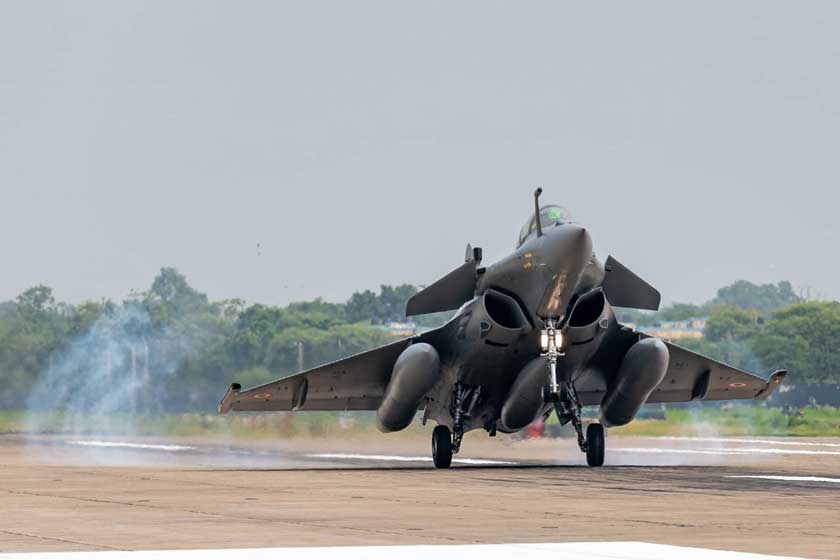
Dassault Rafale in the Indian Air Force

Rafale lands at Ambala base in India after a two-leg flight from France July 27-29, 2020. India has become the third foreign user of French fighters after Egypt and Qatar.
At the end of July 2020, deliveries of 36 Dassault Aviation Rafale multirole fighters to India began. The planes were bought in 2016, which was the culmination (though not as expected) of a program launched at the beginning of the XNUMXth century. Thus, India became the third foreign user of French fighters after Egypt and Qatar. Perhaps this is not the end of the Rafale story in India. It is currently a candidate in two subsequent programs aimed at acquiring new multirole fighter aircraft for the Indian Air Force and Navy.
Since independence, India has aspired to become the greatest power in the South Asian region and, more broadly, in the Indian Ocean basin. Accordingly, even with the proximity of two hostile countries - the People's Republic of China (PRC) and Pakistan - they maintain one of the largest armed forces in the world. The Indian Air Force (Bharatiya Vayu Sena, BVS; Indian Air Force, IAF) has been in fourth place for several decades after the United States, China and the Russian Federation in terms of the number of combat aircraft owned. This was due to intensive purchases made in the last quarter of the 23rd century and the start of license production at the Hindustan Aeronautics Limited (HAL) factories in Bangalore. In the Soviet Union, and then in Russia, MiG-29MF and MiG-23 fighters, MiG-27BN and MiG-30ML fighter-bombers and Su-2000MKI multipurpose fighters were purchased, in the UK - Jaguars fighter-bombers, and in France - XNUMX Mirage fighters (see inset).

Defense Ministers of India Manohar Parrikar and France Jean-Yves Le Drian sign a contract worth 7,87 billion euros for the purchase of 36 Rafale by India; New Delhi, 23 September 2016
However, in order to replace the large fleet of MiG-21 fighters and still maintain the desired number of combat squadrons of 42-44, further purchases were needed. According to the IAF development plan, the Indian light combat aircraft LCA (Light Combat Aircraft) Tejas was to become the successor to the MiG-21, but work on it was delayed (the first technology demonstrator first flew in 2001, instead of - according to plan - in 1990 .). In the mid-90s, a program was initiated to upgrade 125 MiG-21bis fighters to the UPG Bison version so that they could remain in active service until the introduction of the LCA Tejas. Purchase of additional Mirage 1999s and license production of them at HAL was also considered in 2002–2000, but the idea was ultimately abandoned. At that time, the question of finding a successor to the Jaguar and MiG-27ML fighter-bombers came to the fore. At the beginning of the 2015th century, it was planned that both types would be taken out of service around XNUMX. Therefore, the priority was to obtain a new medium multi-role combat aircraft (MMRCA).
MMRCA program
Under the MMRCA program, it was supposed to purchase 126 aircraft, which would make it possible to equip seven squadrons (18 in each) with equipment. The first 18 copies were to be supplied by the selected manufacturer, while the remaining 108 copies were to be produced under a HAL license. In the future, the order can be supplemented with another 63-74 copies, so the total cost of the transaction (including the cost of purchase, maintenance and spare parts) can be approximately from 10-12 to 20 billion US dollars. No wonder the MMRCA program aroused great interest among all the world's major fighter aircraft manufacturers.
In 2004, the Government of India sent initial RFIs to four airlines: French Dassault Aviation, American Lockheed Martin, Russian RAC MiG and Swedish Saab. The French offered the Mirage 2000-5 fighter, the Americans the F-16 Block 50+/52+ Viper, the Russians the MiG-29M, and the Swedes the Gripen. A specific request for proposals (RFP) was supposed to be launched in December 2005 but has been delayed several times. The call for proposals was finally announced on August 28, 2007. In the meantime, Dassault closed the Mirage 2000 production line, so its updated offering was for Rafale aircraft. Lockheed Martin has offered a specially prepared version of the F-16IN Super Viper for India, based on the technical solutions used in the Emirates F-16 Block 60 Desert Falcon. The Russians, in turn, replaced the MiG-29M with an improved MiG-35, while the Swedes offered the Gripen NG. In addition, a Eurofighter consortium with Typhoon and Boeing joined the competition with the F/A-18IN, the "Indian" version of the F/A-18 Super Hornet.
The deadline for applications was 28 April 2008. At the request of the Indians, each manufacturer brought their aircraft (in most cases not yet in final configuration) to India for testing by the Air Force. During the technical evaluation, which ended on May 27, 2009, Rafal was excluded from the further stage of the competition, but after paperwork and diplomatic intervention, he was reinstated. In August 2009, flight tests began over several months at Bangalore, Karnataka, at the Jaisalmer desert base in Rajasthan and at the Leh mountain base in the Ladakh region. Trials of the Rafale began at the end of September.